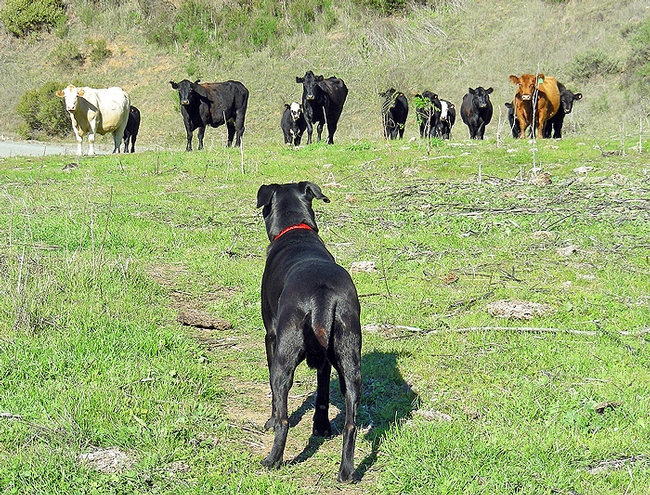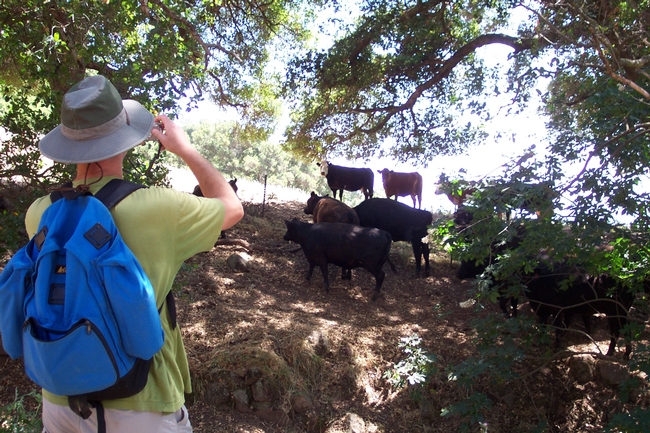Posts Tagged: media
Does social media reveal how we feel about cattle grazing?
To get a more complete picture of public perceptions of cattle grazing, Sheila Barry, University of California Cooperative Extension advisor in the San Francisco Bay Area, analyzed photos and comments in the photo-sharing website Flickr.
Her study, published in the February 2014 issue of Environmental Management, showed that Flickr can provide insight both through photos and comments into public perspectives on grazing in parks and open space lands.
“These are just a first step toward broadening this understanding,” Barry wrote. “Further analysis of social media may provide managers with broader insights into public opinion compared to those afforded by traditional methods on a wide range of issues important to park and open space management.” Livestock grazing reduces the volume of plants that can fuel fire and improves wildlife habitat. But some public land managers, concerned about potential conflicts with park users, limit or ban grazing. In 2009, the city of Walnut Creek decided to end grazing in two city parks. A year later, neighbors who were concerned about weeds contributing to wildfire petitioned the city to resume cattle grazing.
Assessments of public perceptions are often based on public hearings, which tend to attract special interests and favor negative input, or on surveys, which focus on a topic.
“Despite numerous studies that have shown benefits of grazing for endangered species in California, some environmental groups and park users have filed lawsuits to curtail grazing on public rangelands,” Barry said. “I think there's an opportunity to educate people that if grazing is well managed, it won't interfere with their recreational use and there are benefits to society.”
The San Francisco Bay Area has over 133,000 acres of public land that is grazed by cattle and used by people to hike, ride bikes, walk dogs, ride horses and hang glide.
Barry set out to explore how people voluntarily described their feelings about cattle grazing in the San Francisco Bay Area on social media. She examined photos and comments on Flickr. Using the search terms “cow,” “cows” and “grazing,” she found 1,087 photos of grazed regional parks in Alameda, Contra Costa or Santa Clara counties by 328 people with 956 comments.
Of the 733 photos that were accompanied by comments, 71 percent showed a cow and 71 percent of the comments were descriptive without expressing opinion about cows or grazing. Comments included “Lots of wildflowers and cows. Hello tiny cows on the hillside.” “Taken at Lake Del Valle.” “I don't know why, but I thought cows in California were kept indoors.” About 23 percent were positive toward cows and grazing, such as “Wonderful to see cows being just cows and happy ones” and “As much as I struggled over the steep hills on this hike, all the grazing cattle and howling coyotes made it worth the sweat.”
Fear of cows was expressed by 5 percent of commenters and included comments such as “I try to conquer my fear of cows by photographing them,” “The cows scared us to death. I told them that I'm a vegetarian and they let me go” and “We turned around when we were faced with the option of having to walk right through a herd of cows.”
Less than 1 percent described cows behaving aggressively, such as “At least these cows didn't chase us like last week's did.”
Although more research is needed to learn how to collect, analyze and interpret data from social media, Barry believes it could be a valuable source for informing decisions about public policy.
Insight into public perceptions of cattle grazing will enable park managers to craft more effective education and interpretation messages about park use and management.
“We are currently using insight from this project to develop education and interpretative information and panels for parks in the East Bay,” Barry said.
Barry is publishing fact sheets for park managers and interpreters to share with park visitors. The fact sheets will address concerns she saw raised in the Flickr study such as how to safely and comfortably recreate in a park near grazing cattle and the benefits of cattle grazing in parks. She will also address public interest and questions revealed in the Flickr study with facts sheets titled “A Year in the Life” and “Bovines, Ovines, Caprines and Equines: What's the difference?” The fact sheets will also be available online and similar information will be posted in parks on interpretative panels.
The article “Using Social Media to Discover Public Values, Interests, and Perceptions about Cattle Grazing on Park Lands” can be downloaded at http://link.springer.com/article/10.1007%2Fs00267-013-0216-4.
Some farmers are getting into social media
The Fresno Bee reported this morning that farmers are beginning to use social media to communicate with each other and with consumers. The story opens with Kings County dairy operator Barbara Martin, who films herself with a hand-held video camera out on the dairy and posts her messages regularly on a blog, "A Dairy Goddess."
Reporter Robert Rodriguez wrote that Martin writes the blog to dispel myths about farmers and encourage a greater understanding of the slumping dairy industry.
The article revealed an obstacle to the growth of social media in agriculture: many practitioners aren't computer savvy.
For example, the community supported agriculture business, McKellar's Family Farm Fresh, communicates with customers using Twitter, while 30-year farmer Bob McKellar doesn't really know how it's done.
"I have a computer and a cell phone, and to be honest with you I know very little about either one of them," McKellar was quoted. "But what I do know is that these new ways can help reach people like we haven't been able to do before."
Some may be slow to adopt, but when they do come onboard, they will be able to find relevant information. One example is a Twitter feed by UC Cooperative Extension viticulture specialist Matt Fidelibus and viticulture farm advisor Stephen Vasquez called "GrapeTweets." The feed includes useful and interesting 140-character tweets, such as these recent posts:
- Prisoner attempts escape with big bag of raisins: http://bit.ly/5SuYf
- Experts to discuss effect of vineyard smoke exposure on wine quality at UC Davis. Course description and program: http://tinyurl.com/y9ndkrj
- The recent warm weather has been perfect for drying raisins. - http://mobypicture.com/?cxn9x5
GrapeTweets already has 130 followers, but Fidelibus acknowledges the information isn't reaching a critical mass of UCCE's viticulture clientele yet.
"The demographic of the raisin farmers we deal with is skewed more toward older growers, so we are not sure if they use this sort of technology or not," Fidelibus was quoted in the story. "But if we can dispel some of the myths about using Facebook and Twitter, then the potential to reach people could be huge."
UC ANR also has a page on Facebook and a number of active ag-related blogs, including:
Bug Squad, Happenings in the Insect World
Woody Biomass, News and information on woody biomass utilization in California
Postharvest Postings, Postharvest News & Updates from the University of California

UC ANR Facebook page
Parenthetical phrase hits the nail on the head
Sometimes it’s the little side comments people make that are most telling. This could certainly be true in a brief Chico Enterprise-Record story published over the weekend about artisan olive growers. In the lead sentence, business editor Laura Urseny called UC Cooperative Extension “food and farm information central.” That’s a label I think we could get used to. For the brief, UC Cooperative Extension farm advisor Paul Vossen told the writer that about 25 percent of California's olive oil comes from small artisan producers and nearly all California olive oil is fresher and better tasting than imported oil.
Antioxidants a key to brain fitness
A long, slightly irreverent diatribe on brain fitness in the independent online local news conduit the Sacramento News & Review does two things: it offers a UC expert the opportunity to present scientific information and it makes the old-school reader wonder, "Is this really the future of news?"
The article, by Matt Perry, annihilates the rules of conventional journalism:
- Written for the infinite scope of cyberspace, the harangue rambles on for more than 1,500 words.
- Science writing about aging is peppered with teenage slang. Who will read it?
- The writer inserts himself into the piece. To wit: "My eyes shift to (fitness trainer Scott) Estrada, who represents to me the future of health: fit, active, engaged, holistic … and completely responsible for his own health. Welcome to the future of fitness: not just a just a buffer body, but a healthier brain."
To its credit, the article provides UC Davis nutrition professor Liz Applegate a forum for research-based information. She told the writer she likens brain-damaging free radicals to small fires in cubicles around an office. Putting out these free radical fires requires a diet rich in fire extinguishers - antioxidants.
Perry said she recommended:
- A diet of varied colorful foods
- A Mediterranean diet
- Omega-3 fatty acids, folate and choline
In related news, a bastion of traditional journalism, the Associated Press today ran a story about what could be another sign of the traditional news industry's struggles. According to the story, San Francisco investment banker Warren Hellman is teaming up with the UC Berkeley's journalism school and public broadcaster KQED to create a nonprofit news organization to report local news. Bay Area News Project will use a combination of paid reporter/editors and (presumably unpaid) journalism students to produce stories for a Web site, KQED's radio and television outlets, and a print edition.
The making of a blueberry story
Los Angeles Times freelance writer David Karp sent a response today to last week's ANR News Blog post about his May 27 blueberry production story. The nicely written article covered the introduction of a crop usually associated with the Northwest, Michigan and Maine into California; it didn't go into UC's role.
Karp wrote in his e-mail that he agonized over what to include in the article, given the amount of space he would have in the newspaper. He interviewed more than 40 sources, but only had room to cite two.
"If I had room to cite the contribution of three or four persons, and explain what they did, I would certainly have cited (UC Small Farm Program farm advisors) Manuel (Jimenez) and Mark (Gaskell)," Karp wrote. "I'm quite aware of their very substantial contributions to California's blueberry industry."
Karp mentioned that he spent two months of his life and thousands of dollars of his own money to research the article because, "I'm passionate about writing about fruit only when I really know what I'm talking about."
In conclusion, he said, "I apologize to Manuel (Jimenez) and Mark (Gaskell), Ben (Faber) and Gary (Bender) and others, but I'd like to think that they understand that in telling a shortened version of the full story for a newspaper, writers face difficult choices."



